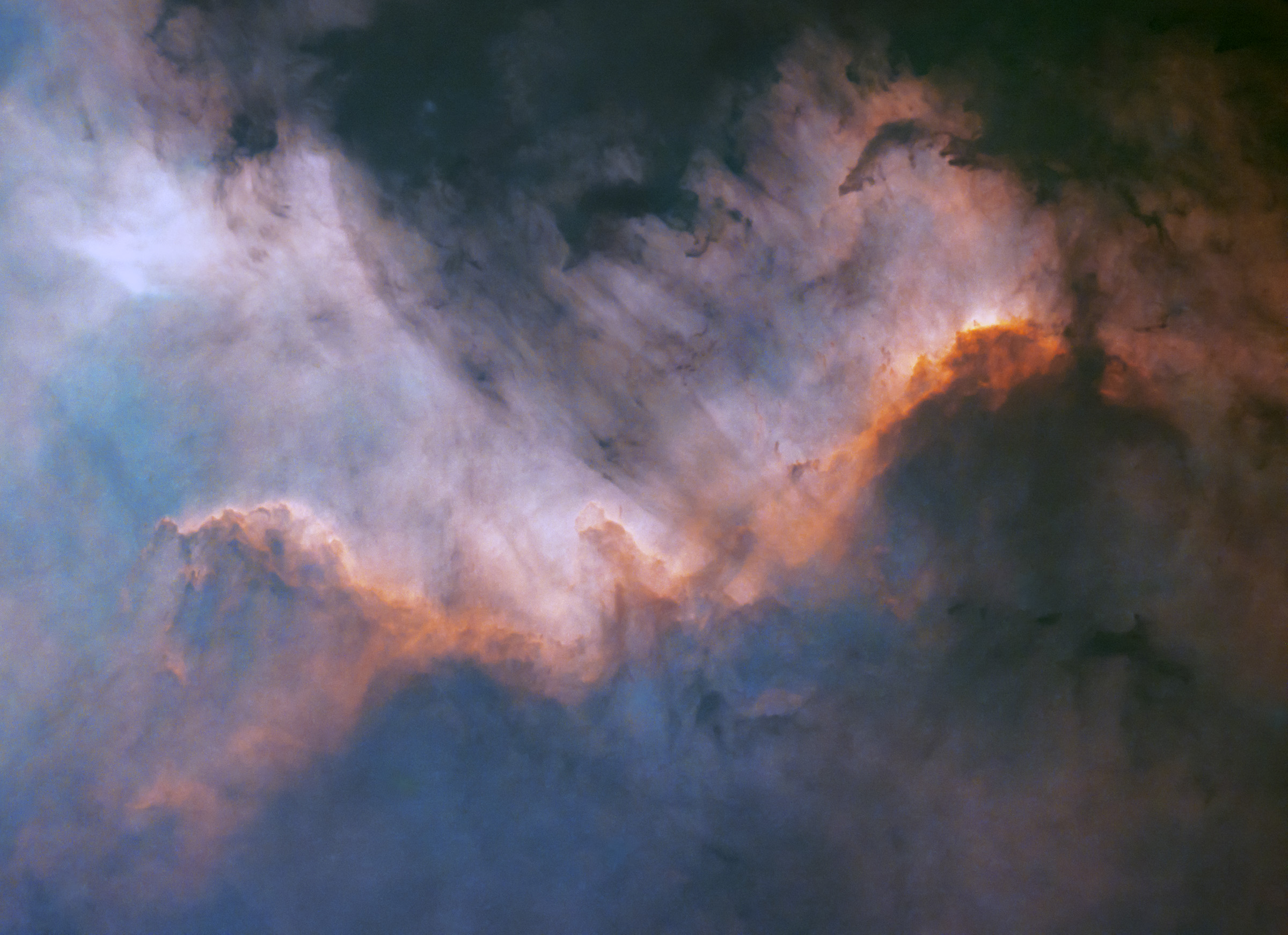Starless NGC 7000 Narrowband
The Cygnus Wall in NGC 7000 (Caldwell 20), the North America Nebula in the constellation Cygnus. These clouds of molecular hydrogen and oxygen are about 2600 lightyears away from us, and to provide some scale, this frame is about a hundred lightyears from one side to the other, or about 600 trillion miles or 950 trillion kilometers. Notes: stars removed with StarNet2 to highlight the softer wisps of dark nebulae scattered in front of the bright emission nebula beyond.
Posted June 12, 2023
NGC 7000 in Cygnus
I bought the Optolong L-eXtreme dual narrowband filter last year, but I haven't seriously used it until last night. Paired with the ZWO ASI071 and the 800mm f/4 Newtonian, I am pleasantly surprised with the data and processed image. The North America Nebula (NGC 7000) in the constellation Cygnus hit 30° above the horizon around midnight, and I spent over 3.5 hours capturing data, 45 x 300-second exposures stacked in DSS. This has to be the most efficient way to get to a bi-color narrowband image, using a single filter and color astronomy camera. These colors are also close to true in terms of where they are on the visible spectrum, with hydrogen-alpha in red and oxygen III in blue.

Posted May 14, 2023
Cygnus Wall in SHO
Narrowband North America Nebula (NGC 7000) in the Constellation Cygnus, with the "Cygnus Wall" across the lower third of the image. You're looking at about 130 trillion miles of dense clouds of ionized hydrogen, with a bit of oxygen thrown in. NGC 7000 is around 1600 lightyears aways, and the "Cygnus Wall" is about 20 light years long. Imaging notes: William Optics GT81 Apochromatic refractor, Astronomik 6-nanometer hydrogen-alpha (Ha), Oxygen 3 (OIII), sulfur 2 (SII) filters, ZWO ASI1600MM-Pro monochrome camera, QHY 5iii178 guide camera, Sky-Watcher EQ6-R Pro Mount.

Posted October 4, 2021
iOptron SkyGuider Pro Test 2
Cygnus region of the Milky Way, with NGC 7000 North America nebula at the bottom left, the Sadr Region in the center, and it's crazy how much of the Veil Nebula showed up--that's the ring of wispy, mostly white nebulosity on the right toward the bottom. The reddish/pinkish areas are mostly clouds of hydrogen gas, while the pale cloudy areas are mostly stars--so many stars. Our galaxy contains somewhere between 150 and 250 BILLION stars. 3 x 120 sec exposures, Nikon D750 85mm f/5.6, on an iOptron SkyGuider Pro tracker.
The SkyGuider Pro has iOptron's standard polar scope and reticle, and by "standard" I mean so much easier to use than just about any other polar scope on the market--that I've used anyway. With just a simple alignment, using the SkyGuider's polar scope, I was shooting 2 and 3 minute exposures. This little tracker is amazingly simple and powerful. At some point I will start testing my color wide-field rig with the William Optics ZS61 and ZWO ASI071MC camera, but for now I want to get used to the SkyGuider, and I'm using my good old Nikon D750 full frame DSLR (unmodified). And you can see this setup produced some decent images to stack.


